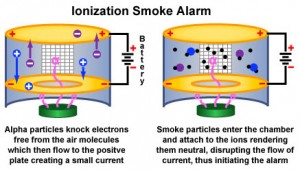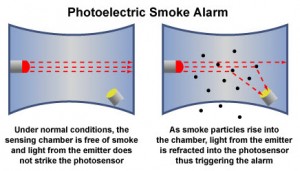Imagine your car air bags deploying randomly when you hit a pothole or speed bump but failing to deploy over half the time in a collision. That is the stark reality with the smoke alarms that are most often found in North American homes. Like most, I had always assumed that a smoke alarm was a smoke alarm. What I now know is that there are two basic types of residential smoke alarms sold in the U.S.: ionization and photoelectric. In real-world fatal fires, these two types of alarms behave very differently. In this case – different is not good. Understanding the difference could very well save your life.
“A smoke detector that sounds approximately nineteen minutes after smoke reached its sensing chamber is like an airbag that does not deploy until nineteen minutes after a car accident.”
– Judge David E. Schoenthaler, Mercer v. Pitway/BRK Brands (First Alert)
 Ionization Smoke Alarms – Generally are more effective at detecting flaming fires, which consume combustibles quickly and spread rapidly. Sources of these fires include paper burning in a wastebasket, or grease fires on a stove.
Ionization Smoke Alarms – Generally are more effective at detecting flaming fires, which consume combustibles quickly and spread rapidly. Sources of these fires include paper burning in a wastebasket, or grease fires on a stove.
Photoelectric Smoke Alarms – Generally are more effective at detecting smoldering fires, which smolder for hours before bursting into flame. Sources of the fires include cigarette smoldering in couches or bedding.
For maximum protection, install both types of smoke alarms on every level of the home.
Silent Alarms; Deadly Differences
Over 90% of U.S. homes have ionization sensor smoke alarms installed. Around 5% of U.S. homes have photoelectric sensor alarms installed. Approximately 4% have no alarm of any kind installed. (footnote 1) Back in the 1960s, residential smoke alarms were almost unheard of and the fire death rate was about 7 to 8 fatalities per 1,000 U.S. home fires. Between the mid-70s and now, we have gone from about 10% of U.S. homes having smoke alarms to 96% of U.S. homes reporting having at least one smoke alarm. (footnote 2) Surprisingly, after installing smoke alarms in over 100 million U.S. homes over 30 years, the odds of dying in a fire remain about the same. Perhaps it’s just me, but that doesn’t make sense.
Between 1977 and 2009 the number of U.S. home fires and fire deaths have fallen by roughly 50%. However, the risk of dying when a fire occurs today is only slightly lower than in the 1970s. Over the period, the rate fluctuates considerably up and down between 6.5 and 10 deaths per 1,000 fires. This brings into question the value of installing hundreds of millions of ionization alarms.
Click Here to Read More… Courtesy of the ASHI Reporter
Reid Guthrie has owned and operated his Home Inspection Seattle company, The Home Detective, since January 1995. As a licensed home inspector, Reid covers Seattle and the surrounding area. If you or someone you know are looking for a thorough Seattle Home Inspector, look no further than The Home Detective ~ The More Thorough We Are, The More Defects We Find, The More Money You Save!
